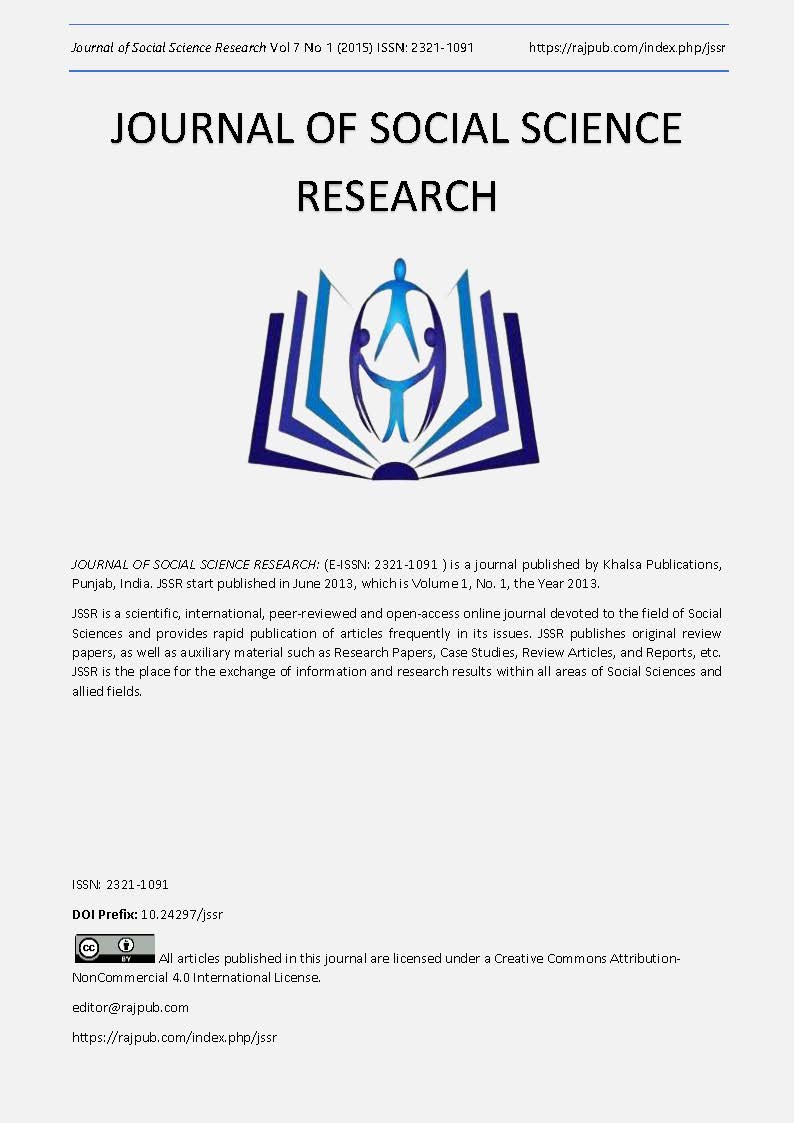Barriers to effective learning by university students on work related learning: A case study of Gweru urban area in the Midlands Province of Zimbabwe
DOI:
https://doi.org/10.24297/jssr.v7i1.6635Keywords:
students, barriers, Work related learning, revisiting of WRL programmes.Abstract
Work Related Learning (WRL) provides a platform for students to link theory and practice. Universities in Zimbabwe have WRL as part of their curricula and whilst some universities refer this programme to as "student attachment", others have adopted the term WRL. The period of student placement at work places may differ among universities. There has however, been a general move from short term periods to longer periods of attachment. When effectively carried out, WRL can benefit students, academic staff / institutions as well as the employer. The aim of this study was to identify barriers to effective learning of students on WRL. A case study was conducted with students on WRL in Gweru urban area. A questionnaire was administered to 50 students who were at 15 different workplaces during the period May-June 2014. Semi-structured interviews were also conducted with a total of eight co-ordinators of the WRL programmesat the Midlands State University in Gweru and supervisors at 12 randomly selected workplaces where students were seconded for the WRL programme. Problems encountered by students on WRL include delays in securing places for attachment, lack of financial incentives to meet basic requirements and limited access to Information Technology and Communication. The study recommends that Universities revisit their WRL programmes to address existing conditions, particularly those of large student numbers and a dwindling industrial base. Policies which permit effective placement and learning of students on WRL at both private and public work-places should also be put in place.
Downloads
References
[2] Stanbury, D., Williams, H. and Rees, J. 2009. Engaging employers to enhance teaching and learning: Ideas and approaches for work related and placement learning. Reading University, UK. Retrieved 24/01/2014 from: http://www.reading.ac.uk/web/FILES/ccms/B02056_Employment_Engagment_AS_V6.pdf [3] Holzer, H.J. and Lerman,R.I. 2014. Work-Based Learning to Expand Jobs and Occupational Qualifications for Youth . Washington DC. Retrieved on 22/01/12 from: http://www.pathtofullemployment.org/wp-content/uploads/2014/04/holzerlerman.pdf [4] Mihail, D.M. 2006. Internships at Greek universities: An exploratory study. J. Workplace Learn. 18(1), 28 – 41.
[5] European Training Foundation (2013). Work-based learning: Benefits and obstacles: A literature review for policy makers and social partners in ETF partner countries. European Commission 2013. Available on: http://www.etf.europa.eu/webatt.nsf/0/576199725ED683BBC1257BE8005DCF99/$file/Work-based%20learning_Literature%20review.pdf. Accessed 13/11/2014)
[6] Gomez, S., Lush, D. & Clements, M. 2004. Work Placements Enhance the Academic Performance of Bioscience Undergraduates, J.Vocat. Educ. Train. 56 (3), 373-386. Retrieved on 15/11/2014 from: http://heer.qaa.ac.uk/SummaryPDFsRestricted/LTA33.pdf [7] Confederation of British Industry, 2009. The Role of Work-integrated Learning in Academic Performance: Is there correlation between industrial placements and degree performance?:Confederation of British Industry Higher Education Task Force. Retrieved on 22/09/14 from:
http://www.waceinc.org/hongkong/linkdocs/papers/UK/Refereed%20Paper%203.pdf
[8] Matamande,W. Nyikahadzoi, L.,Taderera, E. and Mandimika, E. 2008. An investigation of the effectiveness of work related learning: A case of the industrial program offered by the Faculty of commerce, University of Zimbabwe. J.Instr.Pedagog.Retrieved 20/01/2015 from: http://www.aabri.com/manuscripts/131524.pdf
[9] Brown, R (2002). Work related learning “. Report commissioned by the Department for Education and Skills in November 2000. Retrieved on 24/01/2014 from http://tna_r.europarchive.org.
[10]Lam, T. and Ching, L. (2006). An exploratory study of an intership program: The case of Hong Kong students. Hosp.manag. 26,336-351. [11] Donkor, F., Nsor, S.N. and Mitchpal, S.J. (2009). Assessment of supervised industrial attachment of a technical and vocational teacher education program in Ghana.Asia-Pacific. J. Coop. Educ. 10 (Jan. 2009), 1-17. Retrieved on 28/01/2015 from http://www.apjce.org/files/APJCE_10_1_1_17.pdf [12] Bukaliya, R. 2012. The potential benefits and challenges of internship programmes in ODL institution: A case for the Zimbabwe openUniversity.Int.J.NewTrends.Educ.Implic. 3 (Jan. 2012), 118-133. [13] Munzara, A., NhamoMashavira, N. and Mtemeri, J. (2014). Confronting the challenges bedevilling work related learning at a selected university in Zimbabwe: Mentors’ perspectives.Int. J. Engl.Educ. 3 (Apr. 2004), 585-593. [14] Kramer, M. and Usher, A. (2011). Work integrated learning and career-ready Stvs: Examining the evidence .Retrieved 20/12/2014 from http:higheredstrategy.com. [15] Knight, P.T. and Yorke, M. (2004). Learning, curriculum and employability in higher education. London: RoutledgeFalmer. [16] Lester, S. and Costly, C. (2010). Work-based learning at higher education level: value, practice and critique. Stud.High.Educ. 35(5), 561-575. London: Middlesex University. [17] Gill, A. and Lashine, S. (2003). “Business education: a strategic market-oriented focusâ€, Int.J.Educ.Manag. 17 (July, 2003),188-194. [18] Day, H (2010). Work related learning in English studies: A good practice guide. The higher education academy.Landshire.
[19] Abeysekera, I (2006). Issues relating to designing a work integrated learning program in an inadequate accounting degree program and is implications for the curriculum Retrieved on: http://www.apjce.org.Accessed 24/09/14. [20] Brennan, L. (2009). Integrating work-based learning into higher education: A guide to good practice.Bolton: University Vocational Awards Council. [21] Zembylas, M. 2006.Work –based learning, power and subjectivity: Creating space for a foucauldian research ethic. J.Educ.Work, 19(Jul.2006), 291-303.
[22] Angel, B. and Townshed, L (2011). Designing and conducting mixed methods studies. Workshop for the 2011 society for social work and research annual meeting.Retrieved 22/09/2014 from:http://www.sswr.org/Designing%20and%20Conducting%20Mixed%20Methods%20Studies.pdf
[23] Biddix, J.P. ( undated). Mixed research designs. Retrieved 22/09/2014 from http://researchrundowns.wordpress.com/mixed/mixed-methods-research-designs/
[24] Afonja, A.A., Sraku-Lartey, K. And Oni, S.A (2005). Engineering education for industrial development: Case studies of Nigeria, Ghana and Zimbabwe. ATPS working paper No. 42. Nairobi Kenya: The African Rechnology Policy Studies Network. Retrieved on 28/01/2015 from www.atpsnet.org/filed/working_paper_42pdf. [25]Rupande, G and Bukaliya, R. 2013. Challenges of integrating work related learning among open and distance learning students at the Zimbabwe Open University. Int. J. Adv. Res.1(Dec. 2013), 658-668.
[26] Bottoms, G. And McNally, K. 2008. Actions states can take to place a highly qualified career / technical teaching in every classroom. Atlanta, GA: Southern Regional Education Board. Retrieved on 28/01/2015 from http://www.sreb.org/page/1252/publications.html
Downloads
Published
How to Cite
Issue
Section
License
 All articles published in Journal of Advances in Linguistics are licensed under a Creative Commons Attribution 4.0 International License.
All articles published in Journal of Advances in Linguistics are licensed under a Creative Commons Attribution 4.0 International License.




